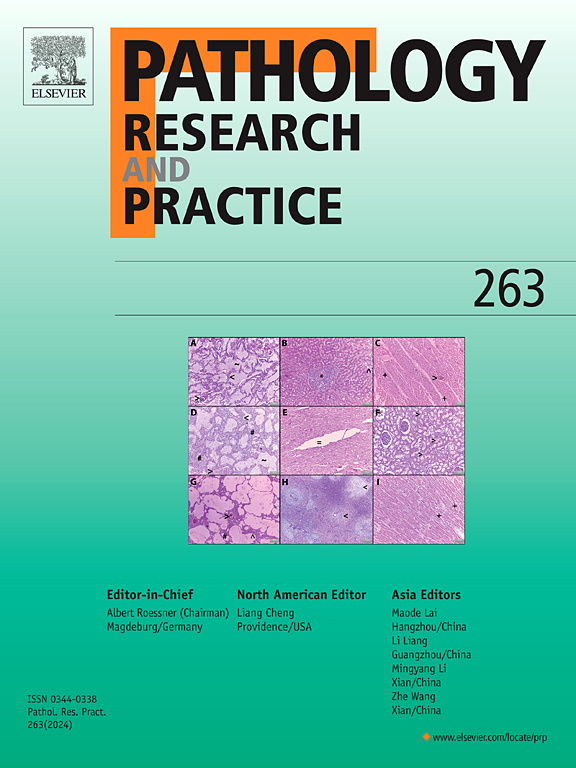Immune cell densities, HLA status, and PD-L1 expression in stage I neuroendocrine neoplasm of the uterine cervix
IF 3.2
4区 医学
Q2 PATHOLOGY
引用次数: 0
Abstract
Neuroendocrine neoplasms (NENs) of the uterine cervix are highly malignant tumors associated with a poor prognosis. Human papillomavirus test-based uterine cervical cancer screening methods can detect early-stage uterine cervical NENs, so therapeutic strategies for the earliest stages are urgently needed. This study aimed to investigate and evaluate the prognostic significance of intratumoral and stromal immune cell densities, as well as human leukocyte antigen (HLA) and programmed cell death ligand 1 (PD-L1) expression in stage I uterine cervical NENs. Sixteen NENs were identified, including 8 large cell neuroendocrine carcinomas (LCNECs), 4 small cell neuroendocrine carcinomas (SCNECs), 3 neuroendocrine tumors (NETs), and 1 LCNEC with an SCNEC component. Only 3 cases were pure NENs, while 13 cases included a component of adenocarcinoma or squamous cell carcinoma. Eight of the 16 patients experienced postoperative recurrence. The recurrence-free group exhibited significantly higher densities of intratumoral CD3- and CD8-positive cells compared to the recurrence group (median densities: 136 vs. 48 cells/mm2, P = 0.0281 and 91 vs. 27 cells/mm2, P = 0.0359, respectively). No significant differences in clinicopathological characteristics, other immune cell densities, or expression of HLA class I, HLA-DR, or PD-L1 were observed between groups. HLA-DR expression was nearly absent in uterine cervical NENs, whereas adjacent non-NEN components displayed varying degrees of HLA-DR expression. PD-L1 expression was observed in 25 % of cases, with CD3- and CD8-positive T-cell-rich stroma. The observed modifications to tumor microenvironments could offer clues to future treatments for uterine cervical NEN. (240/250 words)
免疫细胞密度、HLA状态和PD-L1在I期宫颈神经内分泌肿瘤中的表达
宫颈神经内分泌肿瘤(NENs)是一种预后不良的高度恶性肿瘤。基于人乳头瘤病毒检测的宫颈癌筛查方法可以发现早期宫颈NENs,因此迫切需要针对早期阶段的治疗策略。本研究旨在探讨和评价I期宫颈NENs中瘤内和间质免疫细胞密度以及人白细胞抗原(HLA)和程序性细胞死亡配体1 (PD-L1)表达的预后意义。共发现16例NENs,包括8例大细胞神经内分泌癌(LCNECs)、4例小细胞神经内分泌癌(SCNECs)、3例神经内分泌肿瘤(NETs)和1例伴有SCNEC成分的LCNEC。单纯NENs 3例,腺癌或鳞状细胞癌13例。16例患者中有8例术后复发。与复发组相比,无复发组肿瘤内CD3-和cd8阳性细胞的密度显著更高(中位数密度分别为136 vs. 48个细胞/mm2, P = 0.0281和91 vs. 27个细胞/mm2, P = 0.0359)。两组患者的临床病理特征、其他免疫细胞密度、HLA I类、HLA- dr、PD-L1的表达均无显著差异。HLA-DR在宫颈nen组织中几乎不表达,而邻近的非nen组织则表现出不同程度的HLA-DR表达。在25 %的病例中观察到PD-L1表达,具有CD3-和cd8阳性的富t细胞基质。观察到的肿瘤微环境的改变可能为宫颈NEN的未来治疗提供线索。(240/250字)
本文章由计算机程序翻译,如有差异,请以英文原文为准。
求助全文
约1分钟内获得全文
求助全文
来源期刊
CiteScore
5.00
自引率
3.60%
发文量
405
审稿时长
24 days
期刊介绍:
Pathology, Research and Practice provides accessible coverage of the most recent developments across the entire field of pathology: Reviews focus on recent progress in pathology, while Comments look at interesting current problems and at hypotheses for future developments in pathology. Original Papers present novel findings on all aspects of general, anatomic and molecular pathology. Rapid Communications inform readers on preliminary findings that may be relevant for further studies and need to be communicated quickly. Teaching Cases look at new aspects or special diagnostic problems of diseases and at case reports relevant for the pathologist''s practice.

 求助内容:
求助内容: 应助结果提醒方式:
应助结果提醒方式:


